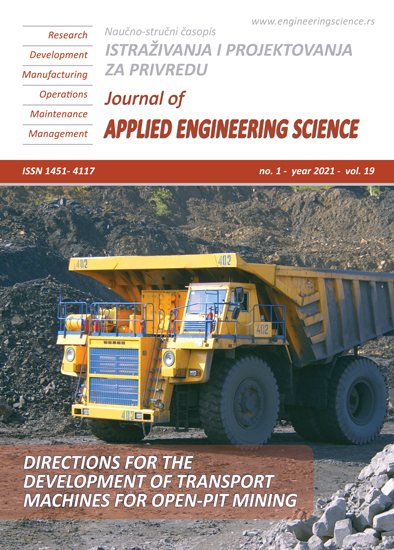THE RELATIONSHIPS BETWEEN COMPRESSIVE STRENGTH AND DENSITY OF POLYSTYRENE LIGHTWEIGHT CONCRETE AND THEIR COMPONENT RATIOS
Abstract
The research deals with the properties of lightweight concrete, made from polystyrene, cement, sand and water, namely the compressive strength and density. This type of lightweight concrete is characterized by thermal insulation, low density and good compressive strength compared to other types of lightweight concrete. It is used as a lining material in inclination surfaces and in the production of unloaded building units and elements. The aim of this paper is to develop mathematical relationships between compressive strength and density of concrete and their mix proportions such as sand to cement ratio (S/C), water to cement ratio (W/C) and polystyrene to cement ratio (P/C). An intensive experimental program has been conducted. From the results of the tests, a mathematical relationships were suggested to find the proportions of components based the required compressive strength and dry density.
References
Neville, A.M. (1981). Properties of Concrete. The Pitman Press, London.
ACI Committee 213R-87 (1987). Guide for Structural Lightweight Aggregate Concrete. ACI Manual of Concrete Practice, Part 1, American Concrete Institute, Farmington Hills.
Kohling, K. (1960).The manufacture of lightweight concrete using pre-expanded styropore particles as aggregates. betorstein – zeitung, Vol. 26, pp. 208 -212.
Maura, G. (1978). Light weight concrete made with expanded substituted polystyrene. IL Cement (Rome), Vol. 75, part 1, pp. 21 – 29.
Parton, G. M., and Shendy–EL– Barbary, M.E. (1982). Poly styrene - beads concrete properties and mix design. Journal of cement composite and light weight concrete, Vol. 4, No 3, pp. 153 – 161.
Sabaa, B., and Ravindrarajah, R.S. (1997). Engineering Properties of Lightweight Concrete Containing Crushed Expanded Polystyrene Waste. Materials Research Society, 1997 Fall Meeting Symposium MM: Advances in Materials for Cementitious Composites December 1-3, Boston, USA
Kuhail, Z., and Shihada, S. (2003). Mechanical properties of polystyrene lightweight concrete. Journal of the Islamic University of Gaza, Vol. 11, No. 2, pp. 93-114.
Kan, A, and Demirboga, R. (2007). Effect of cement and EPS beads ratios on compressive strength and density of lightweight concrete. Indian Journal of Engineering & Materials Sciences, Vol. 14, pp. 158-162
Herki, B.A., Safary, Z., and Khalid, O. (2016). Engineering Properties of Sustainable Lightweight Concrete Using Waste Polystyrene. International Journal of Engineering and Innovative Technology (IJEIT) Volume 5, Issue 12.
Abd, S. M., Dhamya G., Hattem, M., and Khalil, D. (2016). Effective Replacement of Fine Aggregates by Expanded Polystyrene Beads in Concrete. International Journal of Engineering Research and Science & Technology (IJERST), Vol. 5, No. 3.
Duc Hoang Minh, D. H., and Ly Le Phuong, L. L. (2018). Effect of matrix particle size on EPS lightweight concrete properties. MATEC Web of Conferences 251, 01027 (2018), IPICSE-2018 https://doi.org/10.1051/matecconf/201825101027
Bedekovic, G., Grcic, I., Vucinic, A. A., and Premur, V. (2019). Recovery of waste expanded polystyrene in lightweight concrete production. The Mining-Geology-Petroleum Engineering Bulletin, UDC: 624.01, DOI: 10.17794/rgn.2019.3.8
Ubi, Stanley E., Okafor, F. O., and Mama, B. O., (2020). Optimization of Compressive Strength of Polystyrene Lightweight Concrete Using Scheffe‟s Pseudo and Component Proportion Models. SSRG International Journal of Civil Engineering (SSRG-IJCE), Volume 7, Issue 6, June.
ASTM, “Specification for Portland cement,” ASTM C 150, ASTM, West Conshohocken, Pa, USA, 2007.
British Standards Institution, B.S. 882: 1992. Aggregate from natural sources for concrete, London
British Standards Institution, B.S.1881, Part 116, 1989, Method for Determination of Compressive Strength of Concrete Cubes, British Standard Institute London.
ASTM C 642, "Standard Test Method for Density, Absorption, and Voids in Hardened Concrete", Annual Book of ASTM, Standards, Vol. 04.02, 1997.

